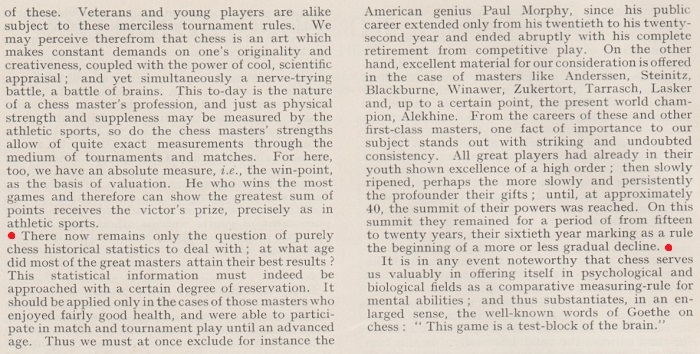
Edward Winter
From page 20 of the programme for the 2002 ‘Russia versus the World’ event in Moscow:

The November 2014 world championship match between Carlsen and Anand will be taking place one month before the latter’s 45th birthday.
C.N. 1288 (see page 127 of Chess Explorations) quoted from page xvii of My Best Games of Chess 1905-1930 by S.G. Tartakower (London, 1953):
‘If one wishes to generalize one might say that as a rule it is towards his 45th year that an intellectual worker is most successful. In my own case it was not till 1930 that at long last I achieved a first prize in a big international tournament in which several great masters competed (at Liège).’
We add now that the same age was specified by Euwe in a Dutch newspaper (can a precise source be found?) quoted on pages 325-326 of the July 1961 CHESS in the context of that year’s return match between Tal and Botvinnik:
‘Writing in a Dutch newspaper before the match, Euwe pointed out that recent tournament results in general had confirmed that the rewards in modern chess go to the younger men.
“Chess masters reach their peak about the age of 45. Alekhine won back the world championship at this age. Capablanca celebrated his 45th year with his success at Moscow and Nottingham, 1936. Lasker was 45 when he won the tournament of St Petersburg, 1914. I myself finished second to Botvinnik at Groningen in 1946, ahead of Smyslov, Szabó, Najdorf and others.
After 45, you begin to go back. Botvinnik lacked his usual certainty in his matches with Smyslov in 1957 and 1958. Capablanca, then 49, failed in the AVRO tournament, 1938 – as I did in the 1948 world championship match-tournament.
Lasker, yes, he was the exception: he won the strong New York tournament of 1924 ahead of Alekhine and Capablanca. The question now is, will Botvinnik prove to be another Lasker or will he follow the general trend?”’
(8876)
In C.N. 1330 (see page 127 of Chess Explorations) Colin McGuigan (Newtownards, Northern Ireland) quoted Arpad Elo on page 19 of the October 1973 CHESS:
‘If a player should reach the master level by age 18, he may expect an advance in proficiency in the next 15 years of approximately a full class interval. However, about ¾ of this advance (150 points) may be registered before age 23, and the remaining portion in the next ten years.’
The same item quoted from page 93 of Elo’s book The Rating of Chessplayers, Past and Present (London, 1978):
‘For players in continuous competition, performance at about age 63 is comparable to that at age 21. Peak performance is attained around age 36, and the average peak is about 120 points higher than the level at ages 21 and 63. The decline is slower than the rise, but it is steady and unremitting, in most cases.’
Fred Reinfeld wrote an article entitled ‘At What Age is a Chess Master at his Best?’ on pages 249-253 of CHESS, 14 March 1936. His conclusion on page 253:
‘In chess, as in every other phase of human activity, an element of the incalculable exists to upset all generalizations. Yet I think I am safe – despite the great exception of Morphy – in stating that the best part of the average chessmaster’s life is between the ages of 36 and 42; this is the conclusion to which consideration of the foregoing and other examples leads. He has then had time to temper the virility of youth with experience, while old age has not begun to affect his powers to any perceptible extent.’
In a feature about Zukertort, Jacques Mieses wrote on page 198 of the September 1942 BCM:
‘In an article which appeared some time ago in the Contemporary Review, and which was reproduced in several English chess publications, I have discussed the interesting and pertinent question: at what age does man reach the zenith of his mental powers? In this article I have pointed out that the experience gained in the field of chess contests provides valuable data for this controversy. Chess statistics show that, although nearly all great chess masters have had remarkable achievements to their credit when still in their teens, they have then developed their gifts slowly and gradually – one might even say the greater their talent, the slower their development – until, at approximately 40, they have reached the summit of their powers.’
Mieses’ earlier article in Contemporary Review was reproduced on pages 154-156 of CHESS, April 1940. From page 156:

Page 273 of our monograph on Capablanca gave his words about Emanuel Lasker on page 12 of the New York Times, 11 January 1936:
‘He beat me in our game in the Moscow tournament last year, and he did it fairly and squarely, with no excuses. He still is the most formidable player I know in a single game or a short match. Of course his age would be too great a handicap for him in a long match.’
A remark by Walter Penn Shipley in his obituary of Lasker in the Philadelphia Inquirer, 9 February 1941, page 18:
‘José R. Capablanca had the greatest respect for the man who surrendered to him the world’s crown, and as recently as 1937 stated that although Dr Lasker on account of his age was hardly capable of doing his best in a match, nevertheless for a single game was still the most dangerous opponent in the world.’
(12156)
To the Chess Notes main page.
To the Archives for other feature articles.
Copyright: Edward Winter. All rights reserved.